start stop button JEEP CHEROKEE 2021 Owner handbook (in English)
[x] Cancel search | Manufacturer: JEEP, Model Year: 2021, Model line: CHEROKEE, Model: JEEP CHEROKEE 2021Pages: 332, PDF Size: 8.87 MB
Page 15 of 332
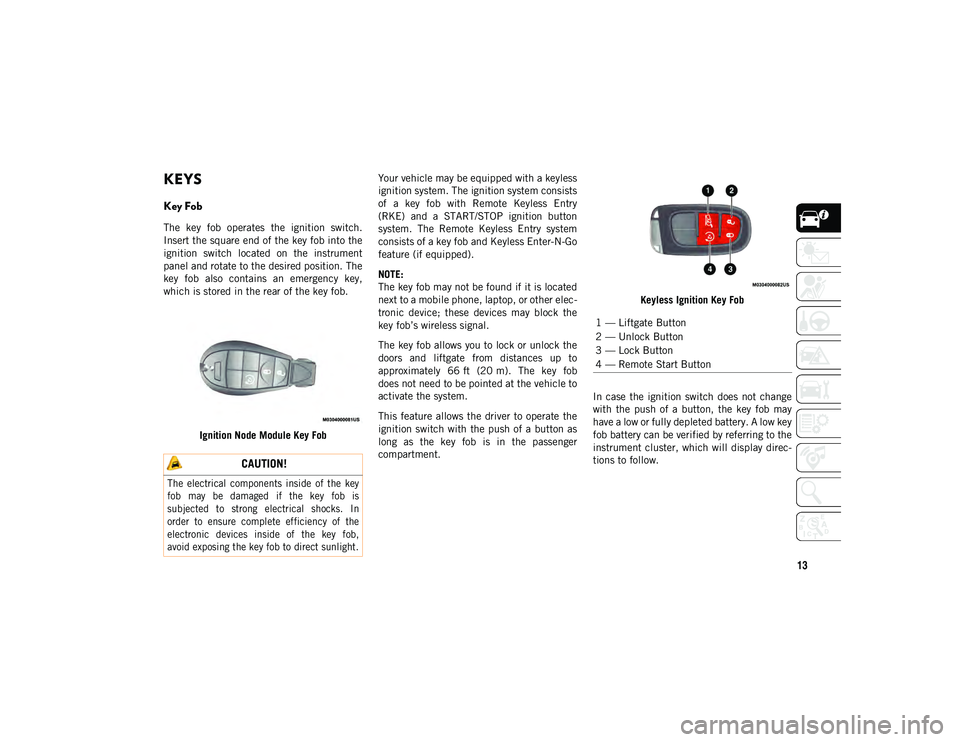
13
GETTING TO KNOW YOUR VEHICLE
KEYS
Key Fob
The key fob operates the ignition switch.
Insert the square end of the key fob into the
ignition switch located on the instrument
panel and rotate to the desired position. The
key fob also contains an emergency key,
which is stored in the rear of the key fob.Ignition Node Module Key Fob Your vehicle may be equipped with a keyless
ignition system. The ignition system consists
of a key fob with Remote Keyless Entry
(RKE) and a START/STOP ignition button
system. The Remote Keyless Entry system
consists of a key fob and Keyless Enter-N-Go
feature (if equipped).
NOTE:
The key fob may not be found if it is located
next to a mobile phone, laptop, or other elec
-
tronic device; these devices may block the
key fob’s wireless signal.
The key fob allows you to lock or unlock the
doors and liftgate from distances up to
approximately 66 ft (20 m). The key fob
does not need to be pointed at the vehicle to
activate the system.
This feature allows the driver to operate the
ignition switch with the push of a button as
long as the key fob is in the passenger
compartment. Keyless Ignition Key Fob
In case the ignition switch does not change
with the push of a button, the key fob may
have a low or fully depleted battery. A low key
fob battery can be verified by referring to the
instrument cluster, which will display direc -
tions to follow.
CAUTION!
The electrical components inside of the key
fob may be damaged if the key fob is
subjected to strong electrical shocks. In
order to ensure complete efficiency of the
electronic devices inside of the key fob,
avoid exposing the key fob to direct sunlight.
1 — Liftgate Button
2 — Unlock Button
3 — Lock Button
4 — Remote Start Button
2020_JEEP_CHEROKEE_UG_RHD_UK.book Page 13
Page 16 of 332
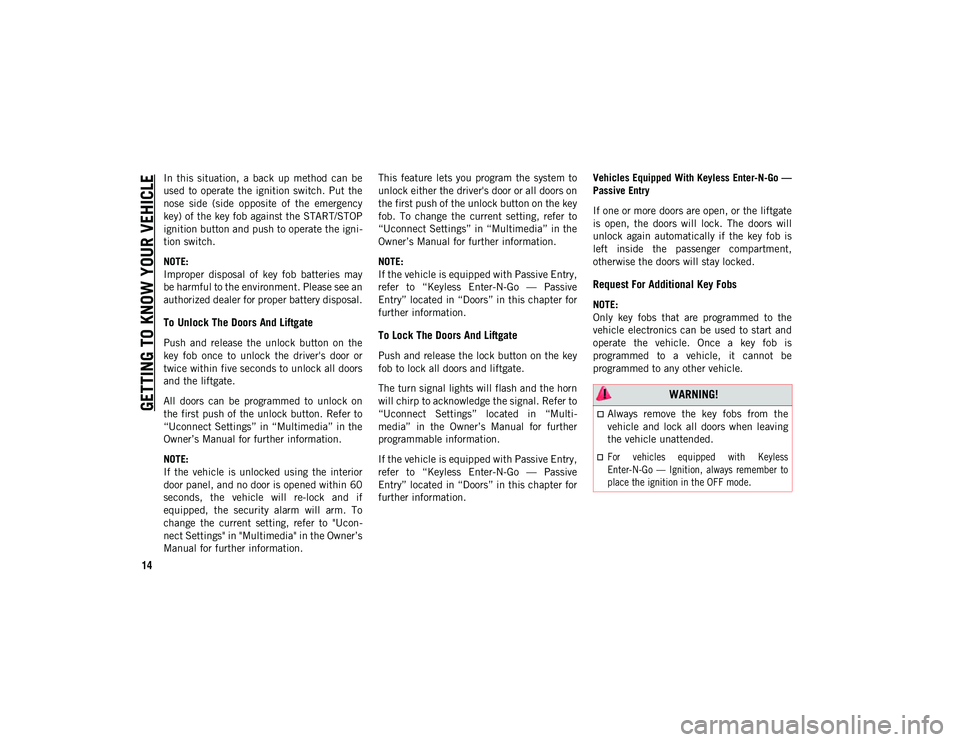
GETTING TO KNOW YOUR VEHICLE
14
In this situation, a back up method can be
used to operate the ignition switch. Put the
nose side (side opposite of the emergency
key) of the key fob against the START/STOP
ignition button and push to operate the igni-
tion switch.
NOTE:
Improper disposal of key fob batteries may
be harmful to the environment. Please see an
authorized dealer for proper battery disposal.
To Unlock The Doors And Liftgate
Push and release the unlock button on the
key fob once to unlock the driver's door or
twice within five seconds to unlock all doors
and the liftgate.
All doors can be programmed to unlock on
the first push of the unlock button. Refer to
“Uconnect Settings” in “Multimedia” in the
Owner’s Manual for further information.
NOTE:
If the vehicle is unlocked using the interior
door panel, and no door is opened within 60
seconds, the vehicle will re-lock and if
equipped, the security alarm will arm. To
change the current setting, refer to "Ucon -
nect Settings" in "Multimedia" in the Owner’s
Manual for further information. This feature lets you program the system to
unlock either the driver's door or all doors on
the first push of the unlock button on the key
fob. To change the current setting, refer to
“Uconnect Settings” in “Multimedia” in the
Owner’s Manual for further information.
NOTE:
If the vehicle is equipped with Passive Entry,
refer to “Keyless Enter-N-Go — Passive
Entry” located in “Doors” in this chapter for
further information.To Lock The Doors And Liftgate
Push and release the lock button on the key
fob to lock all doors and liftgate.
The turn signal lights will flash and the horn
will chirp to acknowledge the signal. Refer to
“Uconnect Settings” located in “Multi
-
media” in the Owner’s Manual for further
programmable information.
If the vehicle is equipped with Passive Entry,
refer to “Keyless Enter-N-Go — Passive
Entry” located in “Doors” in this chapter for
further information. Vehicles Equipped With Keyless Enter-N-Go —
Passive Entry
If one or more doors are open, or the liftgate
is open, the doors will lock. The doors will
unlock again automatically if the key fob is
left inside the passenger compartment,
otherwise the doors will stay locked.
Request For Additional Key Fobs
NOTE:
Only key fobs that are programmed to the
vehicle electronics can be used to start and
operate the vehicle. Once a key fob is
programmed to a vehicle, it cannot be
programmed to any other vehicle.
WARNING!
Always remove the key fobs from the
vehicle and lock all doors when leaving
the vehicle unattended.
For vehicles equipped with Keyless
Enter-N-Go — Ignition, always remember to
place the ignition in the OFF mode.
2020_JEEP_CHEROKEE_UG_RHD_UK.book Page 14
Page 17 of 332
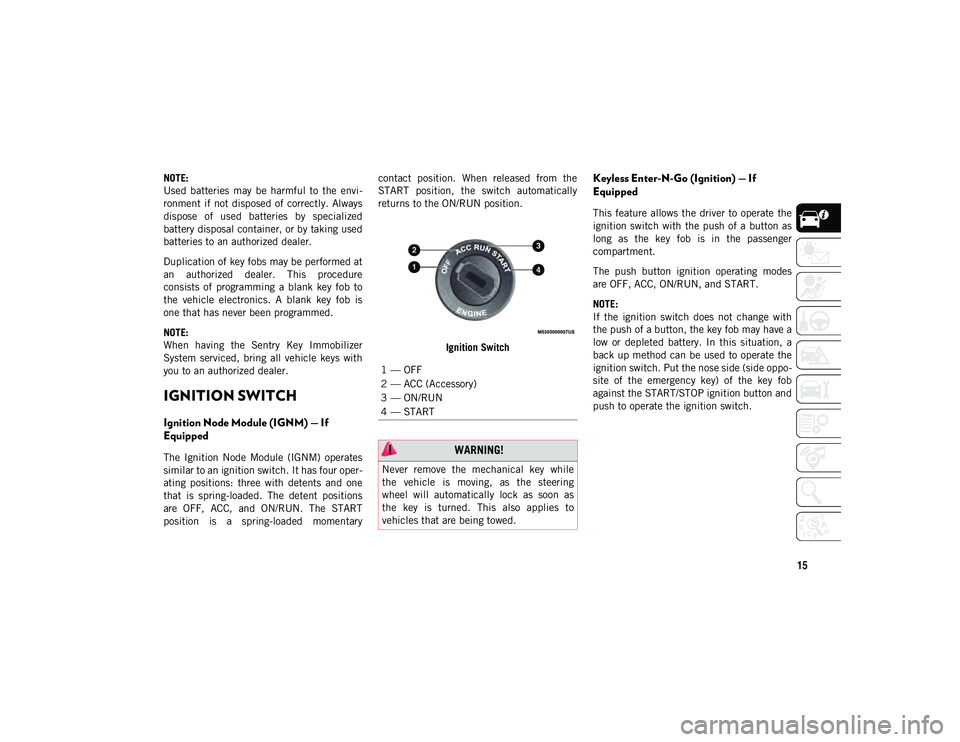
15
NOTE:
Used batteries may be harmful to the envi-
ronment if not disposed of correctly. Always
dispose of used batteries by specialized
battery disposal container, or by taking used
batteries to an authorized dealer.
Duplication of key fobs may be performed at
an authorized dealer. This procedure
consists of programming a blank key fob to
the vehicle electronics. A blank key fob is
one that has never been programmed.
NOTE:
When having the Sentry Key Immobilizer
System serviced, bring all vehicle keys with
you to an authorized dealer.
IGNITION SWITCH
Ignition Node Module (IGNM) — If
Equipped
The Ignition Node Module (IGNM) operates
similar to an ignition switch. It has four oper -
ating positions: three with detents and one
that is spring-loaded. The detent positions
are OFF, ACC, and ON/RUN. The START
position is a spring-loaded momentary contact position. When released from the
START position, the switch automatically
returns to the ON/RUN position.
Ignition Switch
Keyless Enter-N-Go (Ignition) — If
Equipped
This feature allows the driver to operate the
ignition switch with the push of a button as
long as the key fob is in the passenger
compartment.
The push button ignition operating modes
are OFF, ACC, ON/RUN, and START.
NOTE:
If the ignition switch does not change with
the push of a button, the key fob may have a
low or depleted battery. In this situation, a
back up method can be used to operate the
ignition switch. Put the nose side (side oppo -
site of the emergency key) of the key fob
against the START/STOP ignition button and
push to operate the ignition switch.
1 — OFF
2 — ACC (Accessory)
3 — ON/RUN
4 — START
WARNING!
Never remove the mechanical key while
the vehicle is moving, as the steering
wheel will automatically lock as soon as
the key is turned. This also applies to
vehicles that are being towed.
2020_JEEP_CHEROKEE_UG_RHD_UK.book Page 15
Page 18 of 332
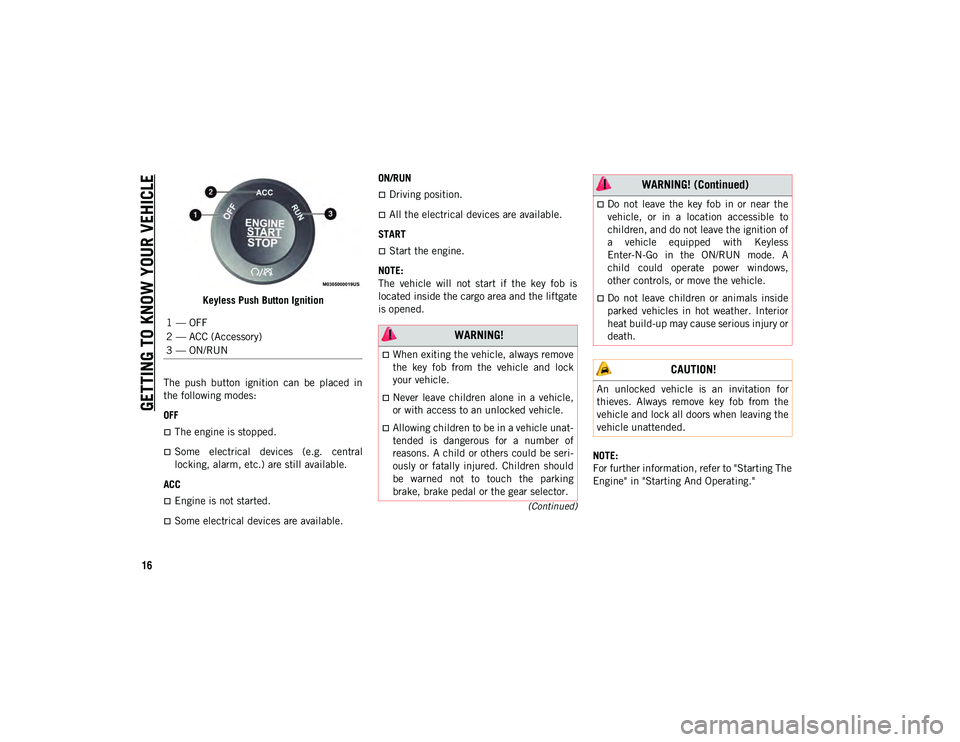
GETTING TO KNOW YOUR VEHICLE
16
(Continued)
Keyless Push Button Ignition
The push button ignition can be placed in
the following modes:
OFF
The engine is stopped.
Some electrical devices (e.g. central
locking, alarm, etc.) are still available.
ACC
Engine is not started.
Some electrical devices are available. ON/RUN
Driving position.
All the electrical devices are available.
START
Start the engine.
NOTE:
The vehicle will not start if the key fob is
located inside the cargo area and the liftgate
is opened.
NOTE:
For further information, refer to "Starting The
Engine" in "Starting And Operating."
1 — OFF
2 — ACC (Accessory)
3 — ON/RUN
WARNING!
When exiting the vehicle, always remove
the key fob from the vehicle and lock
your vehicle.
Never leave children alone in a vehicle,
or with access to an unlocked vehicle.
Allowing children to be in a vehicle unat
-
tended is dangerous for a number of
reasons. A child or others could be seri -
ously or fatally injured. Children should
be warned not to touch the parking
brake, brake pedal or the gear selector.
Do not leave the key fob in or near the
vehicle, or in a location accessible to
children, and do not leave the ignition of
a vehicle equipped with Keyless
Enter-N-Go in the ON/RUN mode. A
child could operate power windows,
other controls, or move the vehicle.
Do not leave children or animals inside
parked vehicles in hot weather. Interior
heat build-up may cause serious injury or
death.
CAUTION!
An unlocked vehicle is an invitation for
thieves. Always remove key fob from the
vehicle and lock all doors when leaving the
vehicle unattended.
WARNING! (Continued)
2020_JEEP_CHEROKEE_UG_RHD_UK.book Page 16
Page 19 of 332
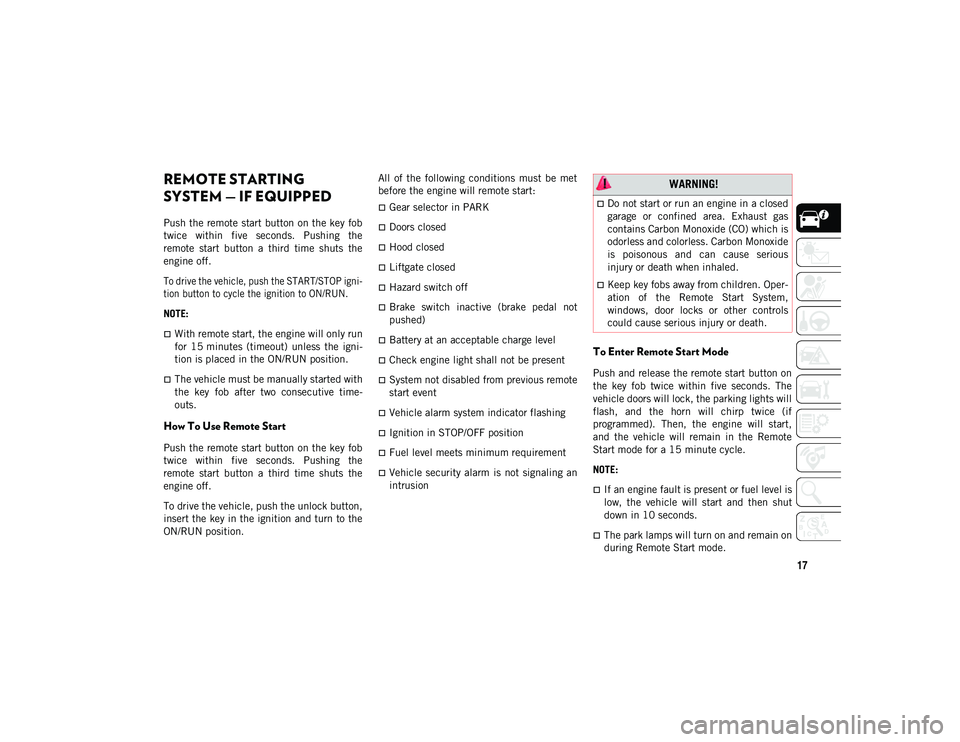
17
REMOTE STARTING
SYSTEM — IF EQUIPPED
Push the remote start button on the key fob
twice within five seconds. Pushing the
remote start button a third time shuts the
engine off.
To drive the vehicle, push the START/STOP igni-
tion button to cycle the ignition to ON/RUN.
NOTE:
With remote start, the engine will only run
for 15 minutes (timeout) unless the igni -
tion is placed in the ON/RUN position.
The vehicle must be manually started with
the key fob after two consecutive time-
outs.
How To Use Remote Start
Push the remote start button on the key fob
twice within five seconds. Pushing the
remote start button a third time shuts the
engine off.
To drive the vehicle, push the unlock button,
insert the key in the ignition and turn to the
ON/RUN position. All of the following conditions must be met
before the engine will remote start:
Gear selector in PARK
Doors closed
Hood closed
Liftgate closed
Hazard switch off
Brake switch inactive (brake pedal not
pushed)
Battery at an acceptable charge level
Check engine light shall not be present
System not disabled from previous remote
start event
Vehicle alarm system indicator flashing
Ignition in STOP/OFF position
Fuel level meets minimum requirement
Vehicle security alarm is not signaling an
intrusion
To Enter Remote Start Mode
Push and release the remote start button on
the key fob twice within five seconds. The
vehicle doors will lock, the parking lights will
flash, and the horn will chirp twice (if
programmed). Then, the engine will start,
and the vehicle will remain in the Remote
Start mode for a 15 minute cycle.
NOTE:
If an engine fault is present or fuel level is
low, the vehicle will start and then shut
down in 10 seconds.
The park lamps will turn on and remain on
during Remote Start mode.
WARNING!
Do not start or run an engine in a closed
garage or confined area. Exhaust gas
contains Carbon Monoxide (CO) which is
odorless and colorless. Carbon Monoxide
is poisonous and can cause serious
injury or death when inhaled.
Keep key fobs away from children. Oper
-
ation of the Remote Start System,
windows, door locks or other controls
could cause serious injury or death.
2020_JEEP_CHEROKEE_UG_RHD_UK.book Page 17
Page 20 of 332
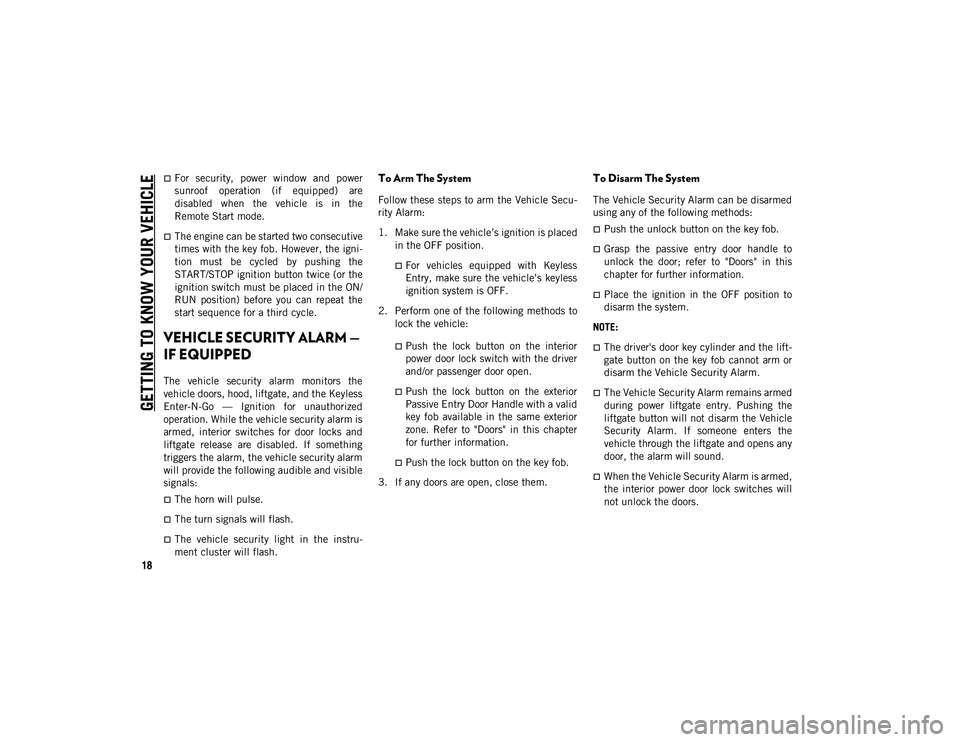
GETTING TO KNOW YOUR VEHICLE
18
For security, power window and power
sunroof operation (if equipped) are
disabled when the vehicle is in the
Remote Start mode.
The engine can be started two consecutive
times with the key fob. However, the igni-
tion must be cycled by pushing the
START/STOP ignition button twice (or the
ignition switch must be placed in the ON/
RUN position) before you can repeat the
start sequence for a third cycle.
VEHICLE SECURITY ALARM —
IF EQUIPPED
The vehicle security alarm monitors the
vehicle doors, hood, liftgate, and the Keyless
Enter-N-Go — Ignition for unauthorized
operation. While the vehicle security alarm is
armed, interior switches for door locks and
liftgate release are disabled. If something
triggers the alarm, the vehicle security alarm
will provide the following audible and visible
signals:
The horn will pulse.
The turn signals will flash.
The vehicle security light in the instru -
ment cluster will flash.
To Arm The System
Follow these steps to arm the Vehicle Secu -
rity Alarm:
1. Make sure the vehicle’s ignition is placed in the OFF position.
For vehicles equipped with Keyless
Entry, make sure the vehicle’s keyless
ignition system is OFF.
2. Perform one of the following methods to lock the vehicle:
Push the lock button on the interiorpower door lock switch with the driver and/or passenger door open.
Push the lock button on the exterior
Passive Entry Door Handle with a valid
key fob available in the same exterior
zone. Refer to "Doors" in this chapter for further information.
Push the lock button on the key fob.
3.
If any doors are open, close them.
To Disarm The System
The Vehicle Security Alarm can be disarmed
using any of the following methods:
Push the unlock button on the key fob.
Grasp the passive entry door handle to
unlock the door; refer to "Doors" in this
chapter for further information.
Place the ignition in the OFF position to
disarm the system.
NOTE:
The driver's door key cylinder and the lift -
gate button on the key fob cannot arm or
disarm the Vehicle Security Alarm.
The Vehicle Security Alarm remains armed
during power liftgate entry. Pushing the
liftgate button will not disarm the Vehicle
Security Alarm. If someone enters the
vehicle through the liftgate and opens any
door, the alarm will sound.
When the Vehicle Security Alarm is armed,
the interior power door lock switches will
not unlock the doors.
2020_JEEP_CHEROKEE_UG_RHD_UK.book Page 18
Page 75 of 332
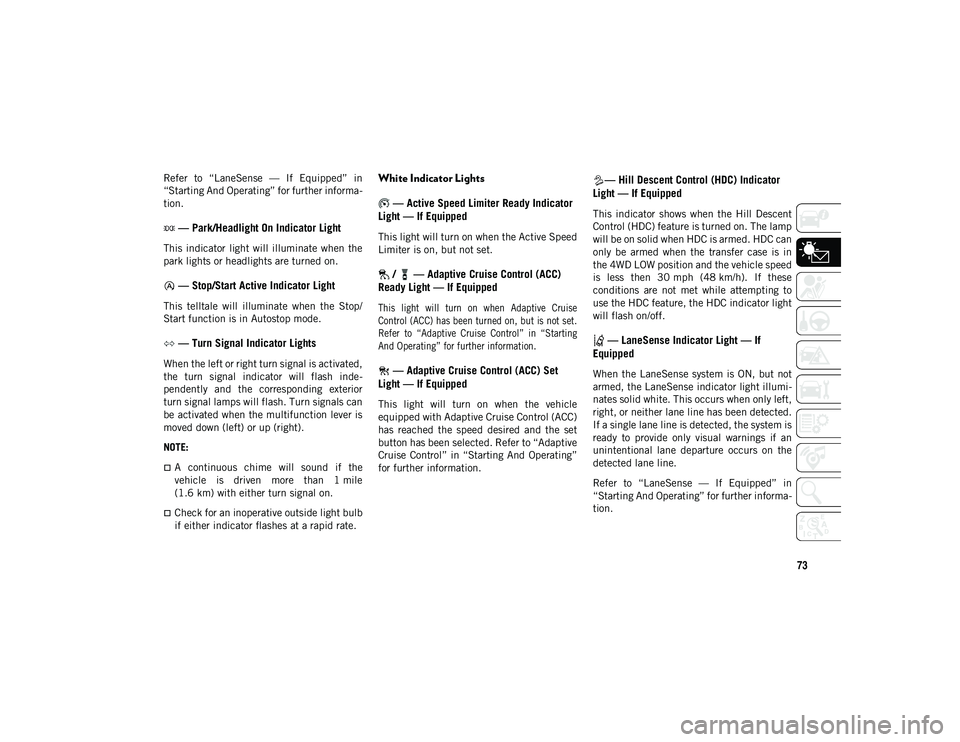
73
Refer to “LaneSense — If Equipped” in
“Starting And Operating” for further informa-
tion.
— Park/Headlight On Indicator Light
This indicator light will illuminate when the
park lights or headlights are turned on.
— Stop/Start Active Indicator Light
This telltale will illuminate when the Stop/
Start function is in Autostop mode.
— Turn Signal Indicator Lights
When the left or right turn signal is activated,
the turn signal indicator will flash inde -
pendently and the corresponding exterior
turn signal lamps will flash. Turn signals can
be activated when the multifunction lever is
moved down (left) or up (right).
NOTE:
A continuous chime will sound if the
vehicle is driven more than 1 mile
(1.6 km) with either turn signal on.
Check for an inoperative outside light bulb
if either indicator flashes at a rapid rate.
White Indicator Lights
— Active Speed Limiter Ready Indicator
Light — If Equipped
This light will turn on when the Active Speed
Limiter is on, but not set.
/ — Adaptive Cruise Control (ACC)
Ready Light — If Equipped
This light will turn on when Adaptive Cruise
Control (ACC) has been turned on, but is not set.
Refer to “Adaptive Cruise Control” in “Starting
And Operating” for further information.
— Adaptive Cruise Control (ACC) Set
Light — If Equipped
This light will turn on when the vehicle
equipped with Adaptive Cruise Control (ACC)
has reached the speed desired and the set
button has been selected. Refer to “Adaptive
Cruise Control” in “Starting And Operating”
for further information.
— Hill Descent Control (HDC) Indicator
Light — If Equipped
This indicator shows when the Hill Descent
Control (HDC) feature is turned on. The lamp
will be on solid when HDC is armed. HDC can
only be armed when the transfer case is in
the 4WD LOW position and the vehicle speed
is less then 30 mph (48 km/h). If these
conditions are not met while attempting to
use the HDC feature, the HDC indicator light
will flash on/off.
— LaneSense Indicator Light — If
Equipped
When the LaneSense system is ON, but not
armed, the LaneSense indicator light illumi -
nates solid white. This occurs when only left,
right, or neither lane line has been detected.
If a single lane line is detected, the system is
ready to provide only visual warnings if an
unintentional lane departure occurs on the
detected lane line.
Refer to “LaneSense — If Equipped” in
“Starting And Operating” for further informa -
tion.
2020_JEEP_CHEROKEE_UG_RHD_UK.book Page 73
Page 82 of 332
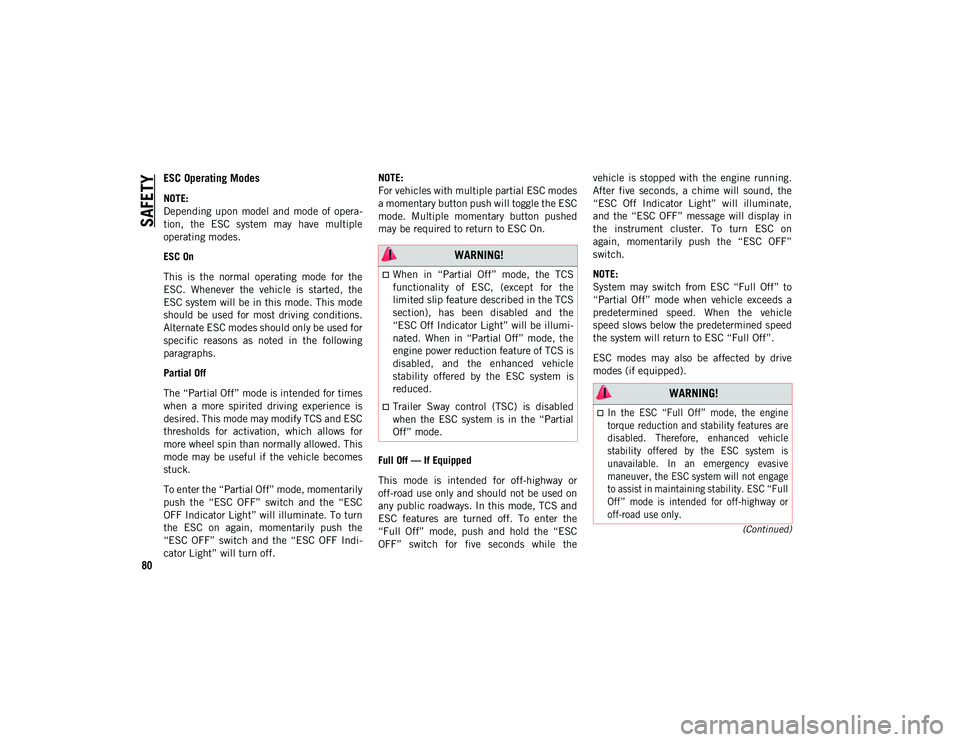
SAFETY
80
(Continued)
ESC Operating Modes
NOTE:
Depending upon model and mode of opera-
tion, the ESC system may have multiple
operating modes.
ESC On
This is the normal operating mode for the
ESC. Whenever the vehicle is started, the
ESC system will be in this mode. This mode
should be used for most driving conditions.
Alternate ESC modes should only be used for
specific reasons as noted in the following
paragraphs.
Partial Off
The “Partial Off” mode is intended for times
when a more spirited driving experience is
desired. This mode may modify TCS and ESC
thresholds for activation, which allows for
more wheel spin than normally allowed. This
mode may be useful if the vehicle becomes
stuck.
To enter the “Partial Off” mode, momentarily
push the “ESC OFF” switch and the “ESC
OFF Indicator Light” will illuminate. To turn
the ESC on again, momentarily push the
“ESC OFF” switch and the “ESC OFF Indi -
cator Light” will turn off. NOTE:
For vehicles with multiple partial ESC modes
a momentary button push will toggle the ESC
mode. Multiple momentary button pushed
may be required to return to ESC On.
Full Off — If Equipped
This mode is intended for off-highway or
off-road use only and should not be used on
any public roadways. In this mode, TCS and
ESC features are turned off. To enter the
“Full Off” mode, push and hold the “ESC
OFF” switch for five seconds while the
vehicle is stopped with the engine running.
After five seconds, a chime will sound, the
“ESC Off Indicator Light” will illuminate,
and the “ESC OFF” message will display in
the instrument cluster. To turn ESC on
again, momentarily push the “ESC OFF”
switch.
NOTE:
System may switch from ESC “Full Off” to
“Partial Off” mode when vehicle exceeds a
predetermined speed. When the vehicle
speed slows below the predetermined speed
the system will return to ESC “Full Off”.
ESC modes may also be affected by drive
modes (if equipped).
WARNING!
When in “Partial Off” mode, the TCS
functionality of ESC, (except for the
limited slip feature described in the TCS
section), has been disabled and the
“ESC Off Indicator Light” will be illumi
-
nated. When in “Partial Off” mode, the
engine power reduction feature of TCS is
disabled, and the enhanced vehicle
stability offered by the ESC system is
reduced.
Trailer Sway control (TSC) is disabled
when the ESC system is in the “Partial
Off” mode.
WARNING!
In the ESC “Full Off” mode, the engine
torque reduction and stability features are
disabled. Therefore, enhanced vehicle
stability offered by the ESC system is
unavailable. In an emergency evasive
maneuver, the ESC system will not engage
to assist in maintaining stability. ESC “Full
Off” mode is intended for off-highway or
off-road use only.
2020_JEEP_CHEROKEE_UG_RHD_UK.book Page 80
Page 95 of 332
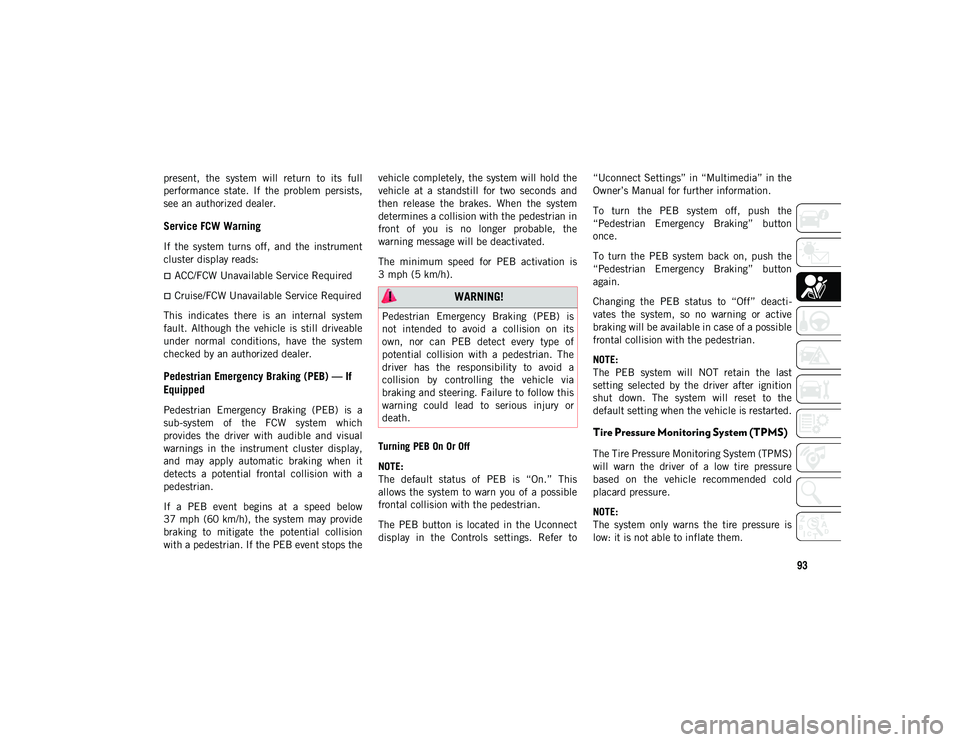
93
present, the system will return to its full
performance state. If the problem persists,
see an authorized dealer.
Service FCW Warning
If the system turns off, and the instrument
cluster display reads:
ACC/FCW Unavailable Service Required
Cruise/FCW Unavailable Service Required
This indicates there is an internal system
fault. Although the vehicle is still driveable
under normal conditions, have the system
checked by an authorized dealer.
Pedestrian Emergency Braking (PEB) — If
Equipped
Pedestrian Emergency Braking (PEB) is a
sub-system of the FCW system which
provides the driver with audible and visual
warnings in the instrument cluster display,
and may apply automatic braking when it
detects a potential frontal collision with a
pedestrian.
If a PEB event begins at a speed below
37 mph (60 km/h), the system may provide
braking to mitigate the potential collision
with a pedestrian. If the PEB event stops the vehicle completely, the system will hold the
vehicle at a standstill for two seconds and
then release the brakes. When the system
determines a collision with the pedestrian in
front of you is no longer probable, the
warning message will be deactivated.
The minimum speed for PEB activation is
3 mph (5 km/h).
Turning PEB On Or Off
NOTE:
The default status of PEB is “On.” This
allows the system to warn you of a possible
frontal collision with the pedestrian.
The PEB button is located in the Uconnect
display in the Controls settings. Refer to
“Uconnect Settings” in “Multimedia” in the
Owner’s Manual for further information.
To turn the PEB system off, push the
“Pedestrian Emergency Braking” button
once.
To turn the PEB system back on, push the
“Pedestrian Emergency Braking” button
again.
Changing the PEB status to “Off” deacti
-
vates the system, so no warning or active
braking will be available in case of a possible
frontal collision with the pedestrian.
NOTE:
The PEB system will NOT retain the last
setting selected by the driver after ignition
shut down. The system will reset to the
default setting when the vehicle is restarted.
Tire Pressure Monitoring System (TPMS)
The Tire Pressure Monitoring System (TPMS)
will warn the driver of a low tire pressure
based on the vehicle recommended cold
placard pressure.
NOTE:
The system only warns the tire pressure is
low: it is not able to inflate them.
WARNING!
Pedestrian Emergency Braking (PEB) is
not intended to avoid a collision on its
own, nor can PEB detect every type of
potential collision with a pedestrian. The
driver has the responsibility to avoid a
collision by controlling the vehicle via
braking and steering. Failure to follow this
warning could lead to serious injury or
death.
2020_JEEP_CHEROKEE_UG_RHD_UK.book Page 93
Page 141 of 332
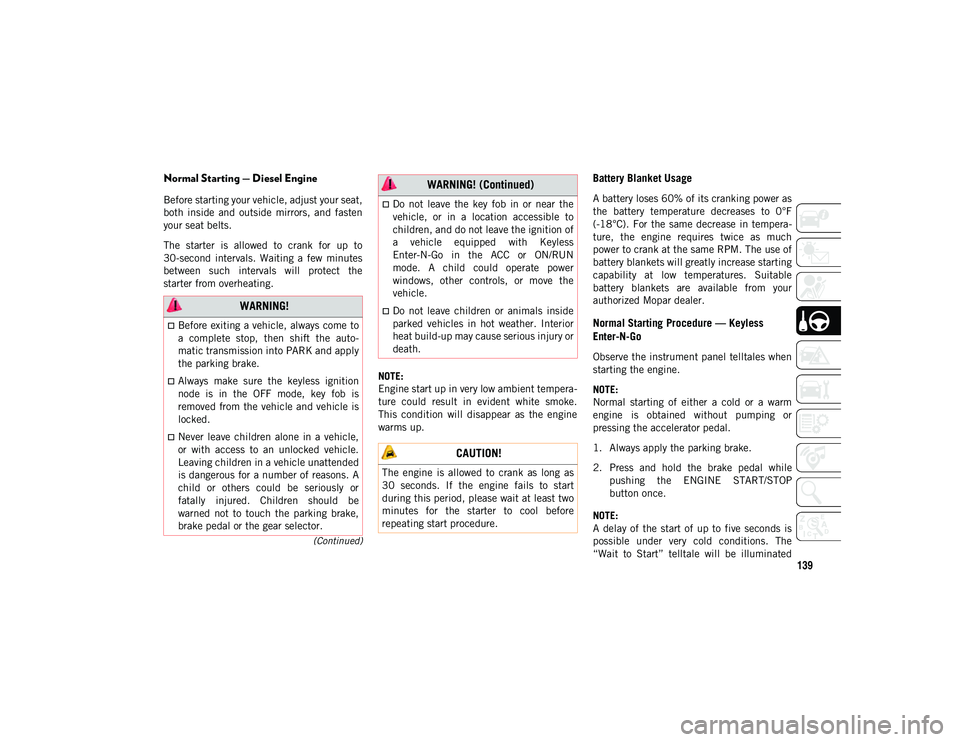
139
(Continued)
Normal Starting — Diesel Engine
Before starting your vehicle, adjust your seat,
both inside and outside mirrors, and fasten
your seat belts.
The starter is allowed to crank for up to
30-second intervals. Waiting a few minutes
between such intervals will protect the
starter from overheating.NOTE:
Engine start up in very low ambient tempera-
ture could result in evident white smoke.
This condition will disappear as the engine
warms up.
Battery Blanket Usage
A battery loses 60% of its cranking power as
the battery temperature decreases to 0°F
(-18°C). For the same decrease in tempera -
ture, the engine requires twice as much
power to crank at the same RPM. The use of
battery blankets will greatly increase starting
capability at low temperatures. Suitable
battery blankets are available from your
authorized Mopar dealer.
Normal Starting Procedure — Keyless
Enter-N-Go
Observe the instrument panel telltales when
starting the engine.
NOTE:
Normal starting of either a cold or a warm
engine is obtained without pumping or
pressing the accelerator pedal.
1. Always apply the parking brake.
2. Press and hold the brake pedal while pushing the ENGINE START/STOP
button once.
NOTE:
A delay of the start of up to five seconds is
possible under very cold conditions. The
“Wait to Start” telltale will be illuminated
WARNING!
Before exiting a vehicle, always come to
a complete stop, then shift the auto-
matic transmission into PARK and apply
the parking brake.
Always make sure the keyless ignition
node is in the OFF mode, key fob is
removed from the vehicle and vehicle is
locked.
Never leave children alone in a vehicle,
or with access to an unlocked vehicle.
Leaving children in a vehicle unattended
is dangerous for a number of reasons. A
child or others could be seriously or
fatally injured. Children should be
warned not to touch the parking brake,
brake pedal or the gear selector.
Do not leave the key fob in or near the
vehicle, or in a location accessible to
children, and do not leave the ignition of
a vehicle equipped with Keyless
Enter-N-Go in the ACC or ON/RUN
mode. A child could operate power
windows, other controls, or move the
vehicle.
Do not leave children or animals inside
parked vehicles in hot weather. Interior
heat build-up may cause serious injury or
death.
CAUTION!
The engine is allowed to crank as long as
30 seconds. If the engine fails to start
during this period, please wait at least two
minutes for the starter to cool before
repeating start procedure.
WARNING! (Continued)
2020_JEEP_CHEROKEE_UG_RHD_UK.book Page 139